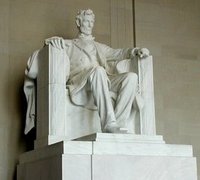Fasces
|
|

Fasces (the plural, almost a plurale tantum, of the Latin word fascis, 'bundle') is a symbol of the highest power and jurisdiction.
It consist of a bundle of birch rods tied together with a red ribbon as a cylinder around an axe.
| Contents |
Antiquity
The fasces lictoriae ("bundles of the lictors") (in Italian, fascio littorio) symbolised power and authority (imperium) in ancient Rome. A corps of Apparitores (subordinate officials) called lictors carried fasces as a sort of staff of office before a magistrate, in a number corresponding to his rank, in public ceremonies and inspections, and bearers of fasces preceded praetors, propraetors, consuls, proconsuls, Masters of the Horse, dictators, and caesars. During the triumphs (public celebrations held in Rome after a military conquest) heroic soldiers (they had to have suffered injury in battle) carried fasces in procession.
Roman historians recalled that twelve lictors had ceremoniously accompanied the Etruscan kings of Rome in the distant past, and sought to account for the number and to provide etymologies for the name lictor.
The symbolism of the fasces at one level suggested strength through unity. The rods symbolized the state's power to punish delinquents. The axe represented the ultimate power of high justice to execute (decapitate), and has a long history in the eastern Mediterranean: see Labrys, the Anatolian and Minoan double-headed axe.
Traditionally the axe blades were removed from fasces inside the Pomerium, the limits of the sacred inner City of Rome. Lictors attending to Dictators, however, kept the axe blades even inside.

Various modern authorities
The following are all cases were fasces have been adopted as a symbol or icon, no actual physical reintroduction as a (highly symbolic) implement
- Napoleon the French Revolution; this emblem remains on the front cover of French passports
- The flag of the Swiss canton of St. Gallen uses the fasces since 1803 (napoleonic era : Switzerland was a satellite state of the French empire)
Kanton_St.Gallen.png
- The Spanish paramilitary police Guardia Civil
- In the 1920s, Italian Fascism, eager to portray itself as a revival of the glorious Roman imperial past, adopted the fasces for its symbol, as an emblem of the increased strength of the individual fascis when bound into the entire bundle
- Used as part of the Knights of Columbus emblem (designed in 1883)

Related Topics
- fascio (usage 1890s to World War I)
- Labrys
- staff of office
External links
- A definition (http://home.uchicago.edu/~janie/fasces.htm)
- Fasces in flags (http://www.crwflags.com/fotw/flags/fasces.html)de:Rutenbündel mit Beil

